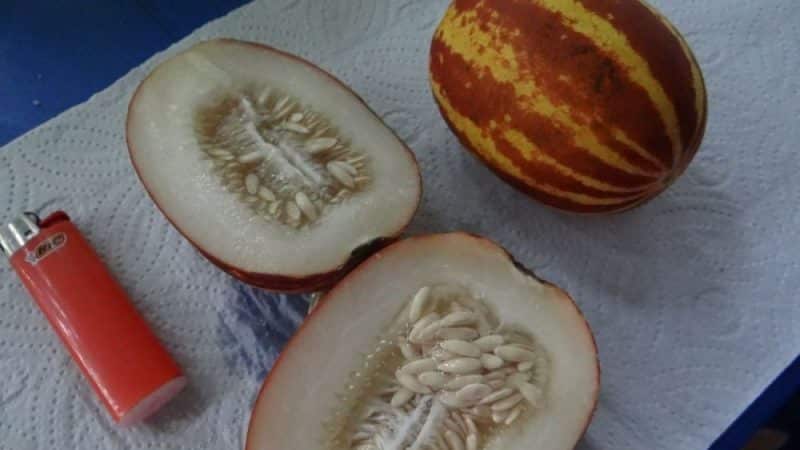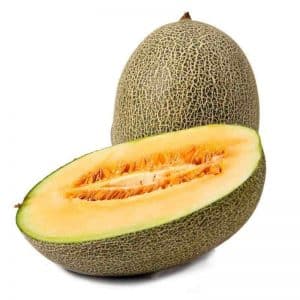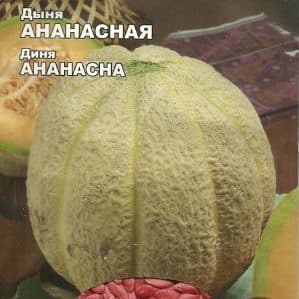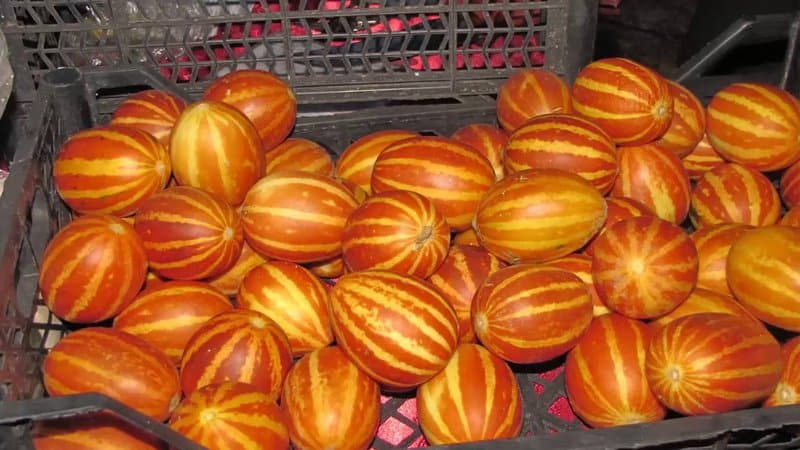Description and characteristics of melon crossed with pineapple: what does the mini-fruit taste like?
Melon crossed with pineapple is one of the most unusual varieties of fruit crops that can be grown in our country. It looks like a regular melon, but it has a tropical pineapple flavor that will surprise even the most experienced gardeners.
Despite its tropical taste, pineapple melon is a relatively unpretentious crop. It is resistant to many diseases and is not afraid of sudden temperature changes.
Description and characteristics of pineapple melon

Pineapple melon is a product of crossing two plants.. It was developed by Dutch breeders at the end of the 20th century. Since then, several hybrids and varieties of this crop have been created, which have gained popularity among farmers around the world.
Pineapple melon is no different in appearance from other representatives of this melon crop. Its main feature is its pineapple flavor. Depending on the variety, it has different degrees of severity.
All hybrids of pineapple melons are resistant to fungal diseases of melons. The plant is productive: one bush produces up to 10 fruits. However, if you do not reduce their number, the fruits will turn out small.

Cold resistance, fruit size and plant ripening time vary among different varieties of pineapple melon. Some of them are able to grow in open ground in regions with temperate and warm climates, while others are grown only in greenhouses.
Varieties of pineapple melon
Since the creation of the first pineapple melon, breeders have managed to develop several varieties and hybrids of this crop.
Melon Pineapple f1
Medium ripening hybrid. About 100 days pass from sowing the seeds to harvesting. It is distinguished by friendly harvest yield. The shape of the fruit is oval.
The weight of each pumpkin (as melon fruits are called) varies between 1.5-2.5 kg. It has a thin yellow-green peel with a pronounced mesh pattern, creamy juicy flesh and a rich sweet taste.
Melon-Pineapple Americano

Early ripe mini-melon. It is distinguished by the unusual appearance of the fruit. They have a bright yellow crust with large red-brown streaks. The fruits are miniature, their weight reaches 400 g. The pulp is white, creamy in consistency, juicy and slightly watery. The aroma of pineapple is rich and the taste is sweet.
American pineapple

Mid-season hybrid. It is characterized by increased cold resistance. The skin is thin, can be green or beige, and always has a pronounced mesh pattern. The flesh closer to the center is creamy, and green at the edges.
Pineapple Gold
Mid-season melon. It has a greenish lumpy skin. The aroma of melon is rich, the taste is sweet. The fruits are round and weigh up to 2.5 kg. The pulp is dense, with an orange or red tint.
Note! The types of melons described have a thin rind. This complicates their transportation.
Chemical composition

Pineapple melon contains a lot of useful substances:
- vitamins A, B, C;
- iron, zinc, fluorine, sodium, potassium, calcium, chlorine, magnesium, phosphorus, iodine, copper;
- amino acids;
- fiber.
Pineapple melon is suitable for dietary nutrition. There are only 39 kcal per 100 g of product.The same amount of pulp contains 7.4 g of carbohydrates, 0.6 g of proteins and 0.3 g of fat.
Beneficial properties for the body and possible harm
Melon has a row useful properties:
- strengthens the nervous system;

- activates the immune system;
- helps to fall asleep with insomnia;
- improves the condition of nails, hair and skin;
- increases hemoglobin levels and stimulates hematopoiesis;
- promotes weight loss;
- cleanses the body of waste, toxins and bad cholesterol;
- has a diuretic effect;
- restores intestinal microflora.
If you consume melon with alcohol, dairy products or on an empty stomach, it will lead to problems with the digestive system.
Contraindications:
- stomach and intestinal ulcers;
- diabetes;
- breastfeeding period;
- gastritis;
- infectious processes in the gastrointestinal tract.
Features of cultivation
The agricultural technology of pineapple melon is not very different from growing other varieties of melons. This is a light-loving plant, demanding on temperature and soil composition.
In regions with a southern climate, seed and seedling cultivation methods are possible. In the central regions, only seedlings are planted in the ground. In colder cities, melon is cultivated in greenhouses.
Preparing seedlings
Seedlings begin to be grown at the end of March or at the end of April, depending on the region. The plants will be ready for planting a month after the first shoots appear.
Important! The colder the climate, the later they begin to plant seedlings.
Before sowing the planting material, it is prepared. This allows you to speed up the process of seed germination and increase their resistance to diseases and negative environmental factors:
- Warming up. 2 weeks before sowing, the seeds are placed near the battery directly in the package.
- Calibration The seeds are sorted, leaving only specimens with uniform color without traces of disease or damage.
- Disinfection. Selected planting material is soaked for half an hour in a light pink solution of potassium permanganate or for a quarter of an hour in hydrogen peroxide.
- Stimulation of growth. The seeds are soaked in a growth stimulator - “Epin”, “Solution”. The duration of soaking depends on the drug used. All instructions are described in the instructions.
- Germination. The seeds are wrapped in damp gauze, placed in a deep container and placed in a warm place. Every day the fabric is moistened with warm water from a spray bottle. This is done until the seeds open.
Melon does not tolerate picking well. Therefore, experienced gardeners sow seeds immediately into individual containers with a height of at least 15 cm. Before use, the containers are soaked for half an hour in a dark pink solution of potassium permanganate.
The soil for seedlings should be loose and nutritious. You can buy it in specialized stores or prepare it yourself by mixing peat and garden soil in equal proportions. Add a glass of ash and 2 kg of sand to a bucket of mixture.
Both purchased and homemade soil mixtures are disinfected by calcining them in the oven or pouring them with a dark pink solution of potassium permanganate. To grow seedlings, drainage is used (crushed ceramics, small crushed stone, shell rock), which is disinfected, like the soil.
Each seed is planted in a separate container, buried 3 cm. After planting, the soil is moistened with warm water from a spray bottle. Containers with seeds are placed in a warm place and covered with film. This will create the greenhouse effect necessary for the germination of planting material.
Seedling care:
- Greenhouse effect. Before the seeds germinate, the film is opened daily for half an hour for ventilation. After germination, it is removed.
- Lighting. It is important to provide pineapple melon seedlings with sufficient light. To do this, it is placed on the window sills of windows that face the south side. If there is not enough natural light, then fluorescent lamps are additionally used. To prevent the seedlings from stretching, they are regularly rotated in relation to the window.
- Watering. The soil is moistened as it dries with warm water from a spray bottle.
- Fertilizers. During the entire period of growing seedlings, they are fed 2 times. The first - 2 weeks after germination (use an ash solution - take 1 glass of product per 5 liters), the second - 5 days before diving into open ground (use potassium-phosphorus fertilizers).
- Hardening. 2 weeks before planting in open ground, seedlings begin to harden. To do this, they take it outside, gradually increasing the stay time - from 15 minutes to 12 hours.
Soil preparation
For melon, choose a well-lit place where groundwater does not lie close to the surface. Other melon crops - pumpkin, melon, watermelon, cucumbers, squash - should not grow in this area over the past two years. Suitable precursors for a pineapple hybrid: nightshades, cruciferous vegetables, legumes, cereals.
Soil preparation begins in the fall. It is dug up and cleared of plant debris. For every 1 m², add 6 kg of humus or manure and 1 glass of ash or dry lime.
Advice. Some gardeners remove roots and seeds from weeds collected from garden beds in the fall and bury them in the ground.
In spring, the soil is dug up and cleared of emerging weeds. For every 1 m², add 15 g of urea and 30 g of superphosphate.Then the beds are leveled with a rake and disinfected by watering them with a hot solution of copper sulfate (2 tablespoons per 10 liters of water).
Rules and landing scheme
Seedlings are planted in open ground at the beginning or end of May. By this time, the soil should warm up to a temperature of 15°C at a depth of 15 cm.
When planting melons, follow a pattern of 80x100 cm. A handful of ash is poured into the bottom of each hole. Seedlings are planted there without deepening the root collar.
The depressions are filled with soil, which is compacted slightly in a circle. Then the soil is watered with warm water. The next watering is possible no earlier than in a week.
For the first two weeks, the seedlings are covered with film at night. This will protect it from night frosts.
Basic rules of care
To get a rich harvest and protect the plants, they need to be properly cared for. Particular attention is paid to watering, fertilizing and shaping.
Melon is sensitive to drought. A special watering schedule is used for it:
- Pineapple melon needs especially frequent watering in the early stages of development. At this time, 0.5 liters of water is poured under each bush every 2 days. As the plants grow, the volume is increased to 3 liters.
- During flowering and ripening, the frequency of watering is reduced. The soil is moistened every 4-5 days.
- A week before harvest, watering is stopped. Thanks to this, the melons will become more sweet.
After each watering, the soil is loosened.
During the season, plants are fed 3 times according to the following scheme:
- The first fertilizing is applied 2 weeks after transplanting seedlings into open ground. To do this, use a solution of ammonium nitrate prepared from 20 g of the product and 10 liters of water.
- The second time, fertilizers are applied during the active formation of buds. Use mullein diluted with water 1:10.
- The third time, fertilizers are applied 2-3 weeks after the previous feeding. To do this, add 30 g of ammonium sulfate, 50 g of superphosphate and 25 g of potassium salt to 10 liters of water. 1 liter of product is used per plant.
The day before fertilizing, the plants are watered abundantly. This will prevent burns on the roots.
Proper formation will ensure good yield and large fruits. Pumpkins are formed on third-order loops.
The first pinching is done by removing part of the main shoot after the fifth leaf. Second-order loops are formed from the axils of the remaining leaves, which are pinched after the fifth leaf. The lower shoot is removed.
On third-order lashes, ovaries are formed. When the future fruits reach 5 cm, the weak loops are removed, leaving 5-6 of the strongest ones.
Advice! To get large fruits, no more than one ovary is left on one shoot.
As the crop grows, the beds are periodically weeded. Experienced gardeners advise mulching the soil to protect the roots from the cold and slow down the growth of weeds.
Attention! Water and plant early in the morning, in the evening or on a cloudy but not rainy day. On the day of planting, the plants are not watered.
Protection from diseases and pests
All varieties of pineapple melons are resistant to late blight, fusarium, powdery mildew, downy mildew and other fungal diseases. There is a possibility that she may be infected with the tobacco mosaic virus, which cannot be treated. To prevent this from happening, it is important to follow the rules of prevention:
- compliance with crop rotation;
- disinfection of soil, garden tools, containers for seedlings and planting material;
- pest control;
- compliance with the rules of watering and pinching.
Melon is often affected pests. They not only feed on plants, but also carry viral infections:
- Aphid. Small flies that feed on plant sap, causing them to wilt.
- Wireworm. Lays larvae that feed on fruits.
- Spider mite. A small pest, when infected, the plant becomes covered with a thin web and dies.
- Melon fly. Lays eggs inside pumpkins, causing them to rot.
When plants are damaged by pests, plantings are sprayed with a soap solution (1 piece of soap per 1 bucket of water), a decoction of wormwood or dandelion, and an ash solution (2 cups of ash per 1 bucket of water).
Near the pumpkin beds I plant aromatic herbs - basil, marigolds, tobacco.
Harvesting
- mesh pattern on crust;
- the fruits are easily separated from the bush;
- leaves turn yellow;
- pronounced aroma emanating from the fruit.
Melons along with the stalk are removed in the morning or at sunset. They are left in the garden for 3 days, turning them over every 5 hours.
Store the harvest in a cool, dry place. He will stay there for up to a month.
Reviews of pineapple melon

Gardeners confirm that pineapple melons are easy to grow and have an unusual taste and aroma.
Irina, Belgorod: «I planted a pineapple melon on the recommendation of a neighbor and did not regret it. Growing a hybrid is no more difficult than the most common melon. The fruits are tasty, with an unusual aroma. I grew regular Pineapple, next year I want to try Americano, the mini-fruits in the photo look very interesting.”
Victoria, Krasnodar: “I have been growing the Pineapple melon variety for several years now. I like its juicy and sweet fruits. There really is a pineapple flavor. I don't use chemicals. I use silage, ash and mullein as fertilizer.”
Igor, Kursk: “Pineapple melons are my favorite.Already in early August I taste the first sweet fruits. The aroma is rich and the taste is sweet. We not only eat it raw, but also use it to make jam and candied fruits.”
Conclusion
Pineapple melon is an excellent alternative to exotic fruits that is easy to grow in your own garden. It has not only an amazing sweet taste and aroma, but also many beneficial properties.
Growing melon crossed with pineapple is an easy process. The plant is resistant to temperature changes and fungal diseases. The main thing is to follow the rules of formation, fertilizing and watering.